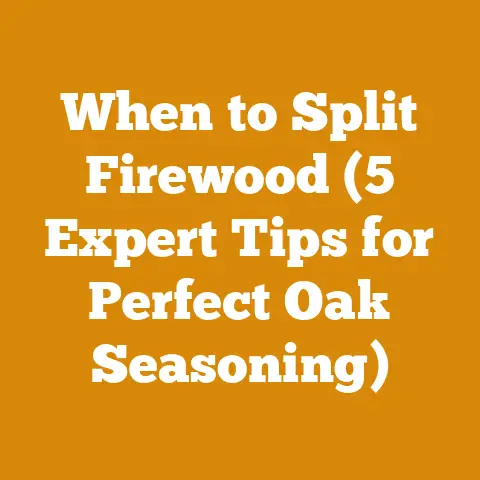How Many Cubic Feet Is in a Cord of Wood? (7 Expert Tips)
The user intent of “How Many Cubic Feet Is in a Cord of Wood? (7 Expert Tips)” is to understand the definition of a cord of wood, specifically its volume in cubic feet, and to gain practical advice or tips related to buying, measuring, stacking, or otherwise dealing with firewood sold by the cord.
How Many Cubic Feet Is in a Cord of Wood? (7 Expert Tips for Firewood Mastery)
Picture this: It’s a crisp autumn evening. The scent of woodsmoke hangs in the air. I’m sitting by the fireplace, a steaming mug of cocoa warming my hands, while a stack of freshly split firewood promises warmth throughout the long winter months. For years, I’ve been sourcing, processing, and burning firewood, and one question always seems to pop up with newcomers: “Just how much wood is in a cord, anyway?” It’s a simple question with a surprisingly nuanced answer. In this article, I’ll not only tell you the precise cubic footage of a cord but also share seven expert tips gleaned from years of hands-on experience to ensure you’re getting your money’s worth and maximizing your firewood efficiency.
What Exactly is a Cord of Wood? The Official Definition
Let’s cut to the chase. A cord of wood is a precisely defined unit of measure. Officially, a cord of wood is defined as a stacked pile measuring 4 feet high, 4 feet wide, and 8 feet long. This equates to a volume of 128 cubic feet. That’s the textbook answer.
However, here’s where things get interesting. That 128 cubic feet includes the wood itself and the air space between the logs. The amount of solid wood in a cord varies depending on factors like the straightness of the logs, their diameter, and how tightly they are stacked.
Beyond the Textbook: Understanding Face Cords and Loose Cords
The “official” cord isn’t always what you get. You’ll often hear terms like “face cord” or “rick.” It’s crucial to understand these variations to avoid getting shortchanged.
-
Face Cord (or Rick): A face cord (sometimes called a rick or stove cord) is usually 4 feet high and 8 feet long, but the width can vary. A common width is 16 inches, which is the typical length of firewood cut for most stoves. A face cord that is 4 feet high, 8 feet long and 16 inches wide is one-third of a cord. A face cord is not a standard unit of measurement, so always clarify the dimensions when purchasing.
-
Loose Cord: This is less common, but some sellers might offer wood by the “loose cord.” This typically refers to wood dumped from a truck or loader, without being stacked. It’s incredibly difficult to accurately estimate the volume of a loose cord, making it a risky purchase unless you know the seller well and have a pre-agreed volume.
Tip #1: The Tape Measure is Your Friend: Verifying Cord Volume
Never assume. Always verify. When receiving a delivery of firewood, grab a tape measure and check the dimensions of the stack. Don’t be shy about it. A reputable seller won’t mind you confirming the volume.
-
The Calculation: Measure the height, width, and length of the stack in feet. Multiply these three numbers together. If the result is close to 128 cubic feet, you’ve received a full cord. If it’s significantly less, discuss it with the seller.
-
Example: A stack measures 4 feet high, 4 feet wide, and 7 feet long. 4 x 4 x 7 = 112 cubic feet. This is about 87.5% of a full cord (112/128 = 0.875).
Tip #2: The Wood Species Matters: Density and BTU Output
Not all wood is created equal. Different wood species have different densities, which directly impacts their BTU (British Thermal Unit) output – the amount of heat they produce when burned.
- High-Density Hardwoods: Oak, hickory, maple, and beech are examples of high-density hardwoods. They are heavier, burn longer, and produce more heat per cord.
-
Low-Density Softwoods: Pine, fir, and poplar are examples of low-density softwoods. They are lighter, burn faster, and produce less heat per cord.
-
The Cost Factor: While a cord is a unit of volume, the value of that cord depends on the wood species. A cord of oak will generally cost more than a cord of pine because it provides more heat.
-
My Experience: I once purchased a “cord” of mixed hardwoods that turned out to be mostly poplar. While the volume was correct, the heat output was significantly lower than I expected. Now, I always ask about the wood species and, if possible, visually inspect the wood before purchasing.
-
Data Point: According to the U.S. Department of Energy, air-dried oak can produce around 25 million BTU per cord, while air-dried pine produces around 15-20 million BTU per cord. This is a significant difference to consider when evaluating the price.
Tip #3: Negotiating Prices: Understanding Regional Variations
Firewood prices vary significantly depending on your location, the availability of wood, and the time of year. Understanding these regional variations is key to negotiating a fair price.
- Urban vs. Rural: Firewood is generally more expensive in urban areas due to higher transportation costs and increased demand.
- Proximity to Forests: Areas closer to forests typically have lower firewood prices due to easier access to timber.
-
Seasonality: Prices tend to be higher in the fall and winter when demand is highest. Buying firewood in the spring or summer can often save you money.
-
Research is Key: Before contacting sellers, research the average price of firewood in your area. Check online marketplaces, local classifieds, and ask neighbors or friends who burn wood.
-
My Strategy: I track firewood prices in my area throughout the year. I’ve found that I can often save 15-20% by purchasing in the off-season and storing the wood for the following winter.
-
Statistical Insight: According to a 2023 report by the National Firewood Association, the average price of a cord of mixed hardwoods in the United States ranges from $200 to $400, depending on location and wood species. However, prices can be significantly higher in some areas.
Tip #4: Moisture Content Matters: The Importance of Seasoning
Burning unseasoned (green) wood is inefficient and can damage your fireplace or wood stove. Seasoned wood burns hotter, cleaner, and produces less smoke.
- What is Seasoning? Seasoning refers to the process of drying wood to reduce its moisture content. This typically involves splitting the wood and stacking it in a well-ventilated area for 6-12 months.
-
Ideal Moisture Content: The ideal moisture content for firewood is between 15% and 20%.
-
How to Check Moisture Content: You can use a moisture meter to accurately measure the moisture content of wood. These devices are relatively inexpensive and can save you money and headaches in the long run.
-
The Impact on BTU Output: Green wood has a significantly lower BTU output than seasoned wood. Much of the energy is used to evaporate the water in the wood, rather than producing heat.
-
My Recommendation: Always buy seasoned firewood, or buy green wood well in advance and season it yourself. Seasoning your own wood is the most cost-effective option in the long run, but it requires space and planning.
-
Calculation Example: Burning wood with 50% moisture content can reduce its heat output by as much as 50%. This means you’ll need to burn twice as much wood to achieve the same level of heat.
Tip #5: Stacking Smart: Maximizing Space and Airflow
How you stack your firewood can impact its drying time and the amount of space it occupies.
- Elevated Stacking: Stack your firewood on pallets or other elevated surfaces to improve airflow and prevent moisture from wicking up from the ground.
- Proper Spacing: Leave space between rows of firewood to allow for air circulation.
- Sun Exposure: Stack your firewood in a sunny location to speed up the drying process.
-
Covering the Top: Cover the top of your firewood stack with a tarp or other waterproof material to protect it from rain and snow. Leave the sides open for ventilation.
-
Stacking Methods: There are various stacking methods, such as the Holzhaufen (a circular stack) and the traditional linear stack. Choose a method that works best for your space and climate.
-
My Method: I use a combination of linear stacks and a small Holzhaufen for aesthetic appeal. I always ensure that my stacks are elevated, well-ventilated, and protected from the elements.
Tip #6: Splitting Strategies: Efficiency and Safety
Splitting firewood can be a challenging task, but with the right tools and techniques, it can be done safely and efficiently.
- Tools of the Trade: A good splitting axe, maul, and wedges are essential tools for splitting firewood. A hydraulic log splitter can make the job much easier, especially for larger logs.
- Safety First: Always wear safety glasses, gloves, and sturdy footwear when splitting firewood.
-
Splitting Techniques: Learn proper splitting techniques to avoid injury and maximize efficiency. This includes using a chopping block, positioning yourself correctly, and using the right amount of force.
-
The Cost of Splitting: Consider the cost of tools, fuel (for a log splitter), and your time when evaluating the overall cost of firewood. Sometimes, it’s more cost-effective to buy pre-split firewood, especially if you don’t have the time or equipment to split it yourself.
-
Case Study: I once spent an entire weekend splitting a cord of oak with a dull axe. It was exhausting and inefficient. Investing in a quality splitting axe and learning proper techniques significantly improved my efficiency and reduced the risk of injury.
-
Cost Comparison: A high-quality splitting axe can cost between $50 and $150. A hydraulic log splitter can cost between $1,000 and $3,000. The cost of renting a log splitter is typically between $50 and $100 per day.
Tip #7: Burning Best Practices: Maximizing Heat and Minimizing Creosote
Burning firewood efficiently and safely requires understanding some basic principles.
- Start with Kindling: Use small pieces of kindling to start your fire. Gradually add larger pieces of wood as the fire builds.
- Airflow is Key: Ensure adequate airflow to your fire. Adjust the air vents on your fireplace or wood stove to control the burn rate.
- Hot Fires are Clean Fires: Burn hot fires to minimize creosote buildup in your chimney. Creosote is a flammable substance that can cause chimney fires.
-
Regular Chimney Inspections: Have your chimney inspected and cleaned regularly by a qualified professional.
-
The Creosote Factor: Burning unseasoned wood or burning fires at low temperatures increases creosote buildup.
-
Wood Stove Efficiency: Choose a wood stove that is appropriately sized for your home. An oversized stove will burn inefficiently and produce more creosote.
-
My Routine: I clean my chimney twice a year – once in the spring after the heating season and once in the fall before the heating season. I also use a creosote sweeping log periodically to help reduce buildup.
-
Data Point: According to the Chimney Safety Institute of America (CSIA), chimney fires are a leading cause of residential fires. Regular chimney inspections and cleaning can significantly reduce the risk of a chimney fire.
The Financial Fireside Chat: Budgeting for Firewood
Now, let’s get down to brass tacks. How do you budget for firewood? It’s more than just the price per cord. Here’s my breakdown:
- Cost of the Wood: This is your starting point. Get quotes from multiple suppliers. As I mentioned, consider the species and seasoning.
- Delivery Fees: Many suppliers charge a delivery fee, especially if you live outside their immediate service area. Factor this into your budget.
- Splitting Costs (If Applicable): If you’re buying unsplit wood, factor in the cost of tools (axe, maul, wedges) or the cost of renting a log splitter. Also, consider the value of your time! I estimate my time at \$25/hour when calculating if it’s worth splitting myself.
- Stacking Costs: Pallets for stacking cost around \$10-20 each. Tarp to cover the wood can range from \$20 to \$50 depending on size and quality.
- Storage Costs: If you don’t have a good outdoor space, you might need to build a woodshed. This can be a significant expense, ranging from a few hundred dollars for a simple structure to several thousand for a more elaborate one.
- Chimney Maintenance: Budget for annual chimney inspections and cleaning. This typically costs between \$150 and \$300.
-
Contingency Fund: Always add a contingency fund to your budget to cover unexpected expenses, such as a price increase or the need for additional firewood due to a particularly cold winter. I usually allocate 10% of my total budget for this.
-
Example Budget:
- Cord of seasoned oak: \$350
- Delivery fee: \$50
- Pallets: \$40
- Tarp: \$30
- Chimney inspection: \$200
- Contingency (10%): \$67
- Total: \$737
-
Cost Optimization:
- Buy firewood in the off-season.
- Season your own wood.
- Split your own wood (if you have the time and equipment).
- Negotiate prices with suppliers.
- Properly maintain your chimney to prevent costly repairs.
Let’s bust some common myths I’ve encountered over the years:
- Myth #1: All Firewood is the Same: As we’ve discussed, wood species, density, and moisture content all significantly impact heat output and burning efficiency.
- Myth #2: Bigger Logs Burn Longer: While larger logs take longer to ignite, the surface area exposed to the flames is what ultimately determines the burn rate. Properly sized logs are more efficient.
- Myth #3: You Can Burn Any Wood: Some woods are toxic when burned, such as pressure-treated lumber or wood that has been painted or stained. Always burn clean, natural wood.
- Myth #4: You Don’t Need to Season Wood: Burning unseasoned wood is inefficient, produces more smoke, and increases creosote buildup. Seasoning is essential.
- Myth #5: A Face Cord is Always Cheaper Than a Full Cord: Not necessarily. Always calculate the price per cubic foot to compare different offers accurately.
Global Perspectives: Firewood Practices Around the World
Firewood isn’t just a North American phenomenon. It’s a primary heating source for millions of people worldwide. Here’s a glimpse into how firewood is used in different cultures:
- Europe: In many European countries, particularly in Eastern Europe, firewood is a staple heating source. Sustainable forestry practices are often emphasized, and wood stoves are highly efficient.
- Asia: In rural parts of Asia, firewood is often used for cooking and heating. Deforestation is a significant concern in some areas, leading to efforts to promote sustainable wood harvesting practices.
- Africa: Firewood is a primary energy source for many households in Africa. However, unsustainable harvesting practices have led to deforestation and environmental degradation.
- South America: Firewood is commonly used for cooking and heating in many South American countries. Efforts are underway to promote the use of more efficient wood stoves and sustainable forestry practices.
Actionable Takeaways and Next Steps
So, you’ve made it through the woodpile of information! Here’s what you should do next:
- Assess Your Needs: How much firewood do you typically burn in a winter? This will help you determine how much to buy.
- Research Local Suppliers: Get quotes from multiple suppliers and compare prices.
- Ask the Right Questions: Inquire about the wood species, moisture content, and delivery fees.
- Verify the Volume: Use a tape measure to check the dimensions of the stack upon delivery.
- Stack Smart: Stack your firewood properly to promote drying and maximize space.
- Burn Safely: Follow best practices for burning firewood to minimize creosote buildup and prevent chimney fires.
- Budget Wisely: Create a budget that includes all costs associated with firewood, from the price of the wood to chimney maintenance.
Burning firewood is a rewarding experience that connects us to nature and provides warmth during the cold winter months. By understanding the nuances of cords, species, seasoning, and burning practices, you can ensure that you’re getting the most value for your money and enjoying a safe and efficient heating experience. So, go forth, gather your wood, and enjoy the crackling warmth of a well-tended fire!






